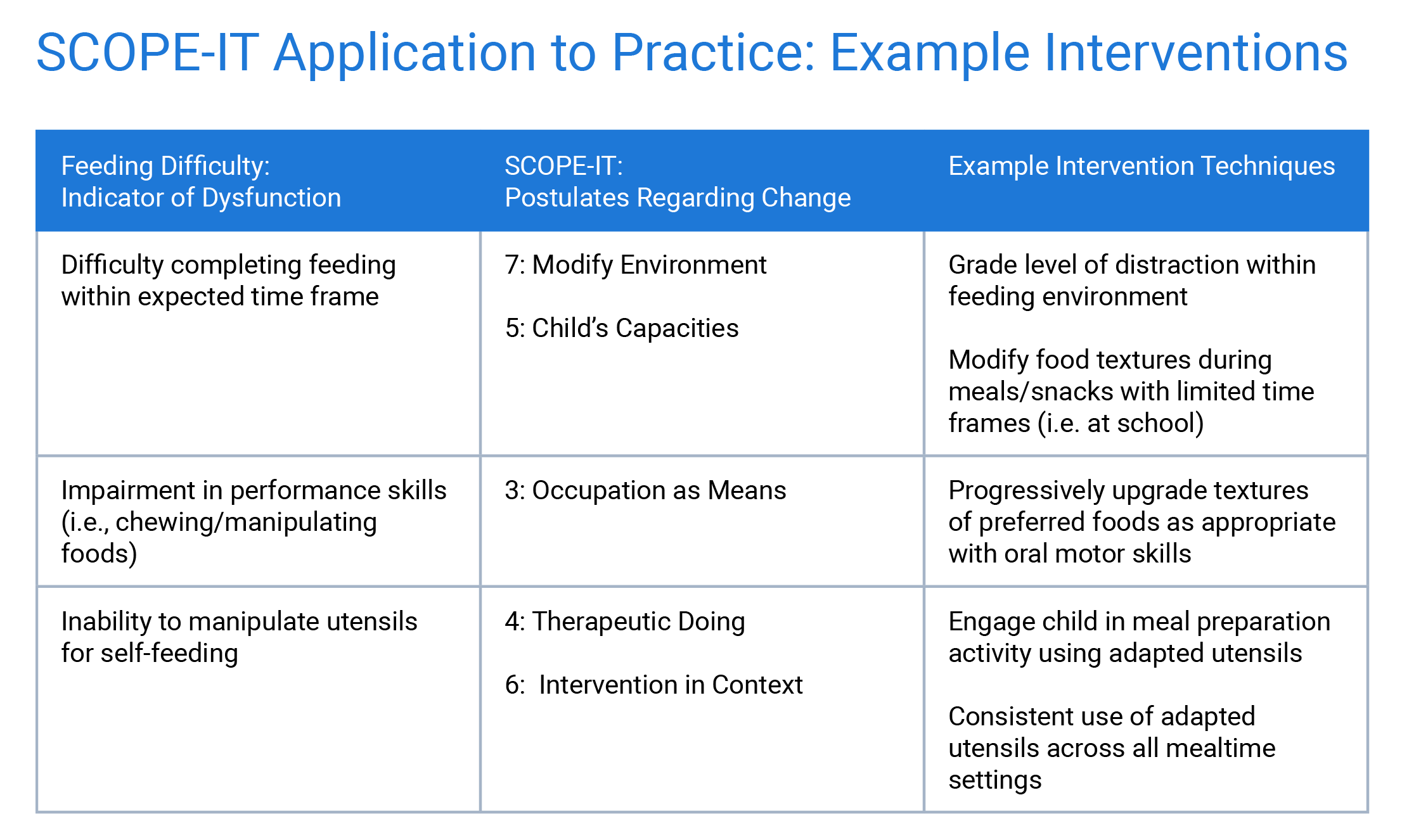SCOPE-IT: Occupation-Based Intervention Planning for Children with Feeding Difficulties

SCOPE-IT – Synthesis of Child, Occupational Performance, and Environment In Time – is a contemporary occupation-based theoretical practice model that informs the occupational therapy process for children with feeding difficulties. Below, we will explore feeding-specific examples of evaluation methods and intervention techniques consistent with the assumptions of SCOPE-IT.
Theoretical Practice Models
Theory guides our interventions and underlies our treatment decisions. You may be saying, “Theory? So what!”, but experienced practitioners tacitly use theory all the time. It’s simply hidden within your more explicit discussions of interventions and other topics. However, recognizing how theory guides the occupational therapy process is a critical professional reasoning skill for practitioners.
More contemporary frames of reference, or theoretical practice models, use a top-down, occupation-based approach to intervention. If you received your education more than a decade ago, you are likely well versed in bottom-up, impairment-based approaches to intervention, but may not have received much formal education on occupation-based approaches, such as SCOPE-IT.
What is SCOPE-IT?
SCOPE-IT is a frame of reference that uses occupation as both means and ends in the therapeutic process.1 SCOPE-IT assumptions acknowledge that:
- Children are occupational and social beings
- Context and environment influence occupational performance
- Occupational development is dynamic and requires guided participation
- Engagement in occupation brings about change, including health and well-being
Frames of reference have a function-dysfunction continuum describing a range of behaviors or abilities from functional to dysfunctional.2 SCOPE-IT considers function-dysfunction in occupations of:
- Work, play and leisure
- ADL or self-care
- Rest or sleep
SCOPE-IT also recognizes that occupational performance may be functional in one situation but not in others due to the influence of diverse environmental and contextual factors. For example, feeding is an ADL occupation. Thus, function and dysfunction in feeding are defined as the ability or inability, respectively, to complete feeding activities to developmental expectations.1
When you use SCOPE-IT, evaluation methods are holistic. They may include child and caregiver interview, functional observations, and administration of standardized or non-standardized assessments for occupational performance. In our feeding example, in addition to evaluating the child, SCOPE-IT guides the clinician to also evaluate occupational performance of feeding in time and the feeding environment.
How do you use SCOPE-IT?
Once you synthesize the diverse evaluation information, the next step is to apply SCOPE-IT postulates for change to select appropriate intervention techniques. These postulates guide therapeutic intervention and help bridge theory to practice.2
For children with feeding difficulties, the following SCOPE-IT postulates of change help us reason about intervention techniques:1
- There is a dynamic interaction between the child-environment-occupation that elicits constant change.
- A client-centered occupation-based approach considers the child and caregivers as primary agents of change in the occupational therapy process.
- The use of occupation as a means enhances occupation as an ends.
- Therapeutic doing that involves true occupational engagement facilitates greater adaptive change than contrived activities.
- Activities within the scope of the child’s capacities that have personal meaning enhance motivation, skill development, and occupational performance.
- Intervention in context promotes specific skill development and generalization of occupational performance.
- The modification and creation of supportive environments facilitate improved occupational performance.
- The establishment of healthy performance patterns facilitates outcomes of well-being and quality of life.
Example Interventions
This is what you have been waiting for! What do the assumptions of SCOPE-IT and its postulates about change look like in everyday practice? Here are some general examples of intervention techniques for common difficulties with feeding presented in relationship to SCOPE-IT postulates about change presented above:
Interventions that align with SCOPE-IT include the use of prompts and feedback, grading of activities, and opportunities for repeated, contextualized practice. Remember, as an experienced practitioner, your underlying theoretical thinking about occupational performance is an important part of professional reasoning and your ability to articulate the need for your occupational therapy services.
- Haertl, K. (2010). A frame of reference to enhance childhood occupations: SCOPE-IT. In P. Kramer & J. Hinojosa (Eds.), Frames of Reference for Pediatric Occupational Therapy, 3rd Ed., (pp. 266-305), Philadelphia, Lippincott Williams & Wilkins.
- Kramer, P. & Hinojosa, J. (Eds.). (2010). Frames of Reference for Pediatric Occupational Therapy, 3rd Ed. Philadelphia, Lippincott Williams & Wilkins.










